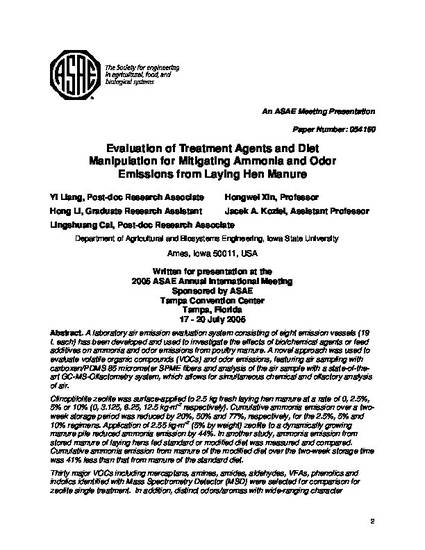
A laboratory air emission evaluation system consisting of eight emission vessels (19 L each) has been developed and used to investigate the effects of bio/chemical agents or feed additives on ammonia and odor emissions from poultry manure. A novel approach was used to evaluate volatile organic compounds (VOCs) and odor emissions, featuring air sampling with carboxen/PDMS 85 micrometer SPME fibers and analysis of the air sample with a state-of-the-art GC-MS-Olfactometry system, which allows for simultaneous chemical and olfactory analysis of air.
Clinoptilolite zeolite was surface-applied to 2.5 kg fresh laying hen manure at a rate of 0, 2.5%, 5% or 10% (0, 3.125, 6.25, 12.5 kg·m -2 respectively). Cumulative ammonia emission over a two-week storage period was reduced by 20%, 50% and 77%, respectively, for the 2.5%, 5% and 10% regimens. Application of 2.55 kg·m -2 (5% by weight) zeolite to a dynamically growing manure pile reduced ammonia emission by 44%. In another study, ammonia emission from stored manure of laying hens fed standard or modified diet was measured and compared. Cumulative ammonia emission from manure of the modified diet over the two-week storage time was 41% less than that from manure of the standard diet.
Thirty major VOCs including mercaptans, amines, amides, aldehydes, VFAs, phenolics and indolics identified with Mass Spectrometry Detector (MSD) were selected for comparison for zeolite single treatment. In addition, distinct odors/aromas with wide-ranging character descriptors and intensity determined by human nose were also compared. Consistent emission reduction was shown for trimethyl amine, VFAs, 4-ethyl-phenol and skatole, with relatively lower odor intensity. Dimethyl trisulfide was substantially increased in 10% treatment. The effects of zeolite on reduction or generation of VOCs were generally proportional to the application rate. Overall odor in poultry manure was controlled by zeolite treatment.
Ongoing studies will continue to identify, quantify and optimize other alternative agent(s) or diet manipulation to effectively reduce gaseous emissions from poultry manure.
Available at: http://works.bepress.com/jacek_koziel/27/

This is an ASAE Meeting Presentation, Paper No. 054160.